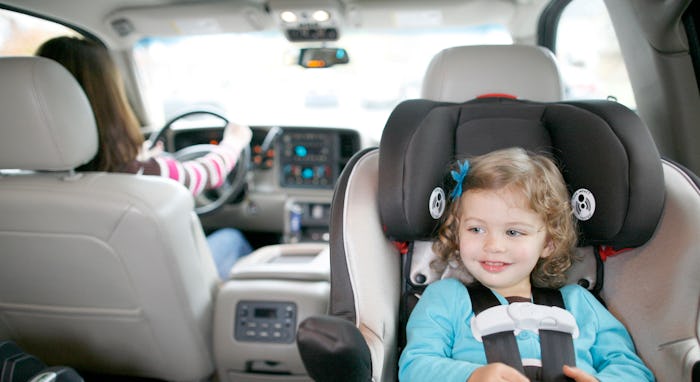Life

Everything You Need To Know About Your Car Seat's Top Tether
Parents put the safety and well-being of their children above all else, regardless of cost or inconvenience, but that doesn't mean some safety measures aren't confusing. If you're strapping your little one into a car seat, you might wonder, "do I need to use the top tether on the car seat, or can I make do without it?" After all, it can be a pain to use, especially if you're moving the car seat to a new car. But it turns out, using that tether is pretty important, and when to use it will depend on your child's weight and the suggested guidelines of your car seat manufacturer.
According to The Car Seat Lady, the tether that hangs from the back of a car seat is the top part of the Lower Anchors and Tethers for Children (LATCH) system, and is a tether strap that connects to an anchor in your car, usually behind the vehicle's seat, depending on the make and model. The top tether is used when a car seat or booster seat becomes forward-facing, and needs to be held tight against the seat back.
Community safety expert, Sarah Brown, tells Romper that the LATCH system is meant to be a simpler way to install car seats in an effort to fool-proof the process, but some cars have difficult to reach LATCH anchors. While she doesn't advocate using one harnessing mechanism, like your car's shoulder and lap belt, over another, like the LATCH system, she does suggest strapping your child correctly into a properly installed car seat as designed and taking your child's weight into consideration. "The heavier your child becomes, the safer they are with a typical seat belt harnessing them in," she adds.
According to USA Today, the National Highway and Traffic Safety Administration conducted crash tests, and found that when children and their car seats reach a combined weight of 65 pounds, it is safer for them to be strapped in with the vehicle's shoulder and lap belt through their child safety seat, because in an impact, the force and weight may be too much for the car's anchors, and they may get pulled right out of the car.
When children and their car seats are under 65 pounds, it is always safer to use both the top and lower harnesses together to secure the car seat to the car, suggested the NHTSA. Ohio State University's Buckle Up with Brutus program noted that when the top harness is not tethered in, a child's head can be thrown forward an extra 4 to 6 inches in a collision.
The NHTSA recommended that you review your child's car seat's instructions and your vehicle's owner's manual thoroughly to see the specified weight limitations for proper installation. When your child goes over the weight limits from the manufacturers, you should stop using the LATCH tethers, and correctly use the vehicle's shoulder and lap safety belts to install the car seat.
Safety is a parent's priority, and knowledge is their weapon. Knowing and fully understanding the limitations and guidelines of your child's safety seat will help your family enjoy the safest of travels.